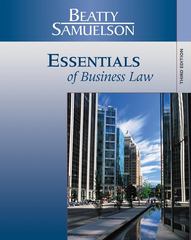Question
2. Ambrose, the nut and berry consumer, has a utility function U(x1, x2) = 4 x1 + x2, where x1 is his consumptin of nuts
2. Ambrose, the nut and berry consumer, has a utility function U(x1, x2) = 4 x1 + x2, where x1 is his consumptin of nuts and x2 is his consumption of of berries.
(a) Suppose that the price of a unit of nuts is 1, the price of a unit of berries is 2, and Ambrose's income is 24. How many nuts and berries does he choose to buy?
(b) Suppose that the price of nuts is still 1 and the price of berries 2, but Ambrose's income is only 9. Draw his budget line. Is there any indifference curve tangent to the budget line? What is Ambrose's optimal consumption bundle?
(c) Draw the income offer curve and Engel curve.
3. Joan buys gasoline and food. When the price of gasoline is $1.00 per gallon, she buys 50 gallons per week and spends $50 on food per week. the government want to reduce consumption of gasoline as part of an environmental policy and is considering two alternatives. They are: (1) restrict the number of gallons of gasoline anyone can buy to 40 gallons per week, and (2) Raise the price of gasoline to $1.25 per gallon. Assume for simplicity that food always costs $1 per unit.
(a) Show on a graph Joan's initial budget line and the budget lines under policy (1) and policy (2).
(b) Suppose that Joan's most preferred market basket under policy (2) is to consume 40 gallons per week. Show this on the consumption diagram. Would Joan be better off under policy (1) or (2)?
(c) If Joan's preferred market basket under policy (2) is to consume 70 gallons per week, would your answer to (b) change?
4. Our old friend, Edmund Stench loves punk rock video tapes. He has no income and therefore has to accept garbage in his backyard in return for money. Each video tape cost $2 and each sack of garbage that he accepts brings him $1. His utility function is given by U(c, g) = min{2c, 20 g}, where c is the number of video tapes and g is the number of sacks of garbage that he gets per month. 1
(a) Show on a graph Edmund's budget set.
(b) Draw Edmund's indifference curves. (Hint: Be careful about where the kinks occur and in which direction the utility increases.)
(c) Find the optimal consumption bundle.
Step by Step Solution
There are 3 Steps involved in it
Step: 1

Get Instant Access to Expert-Tailored Solutions
See step-by-step solutions with expert insights and AI powered tools for academic success
Step: 2

Step: 3

Ace Your Homework with AI
Get the answers you need in no time with our AI-driven, step-by-step assistance
Get Started


